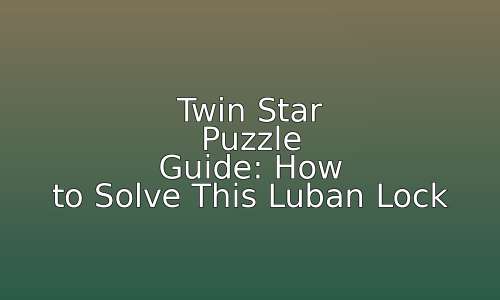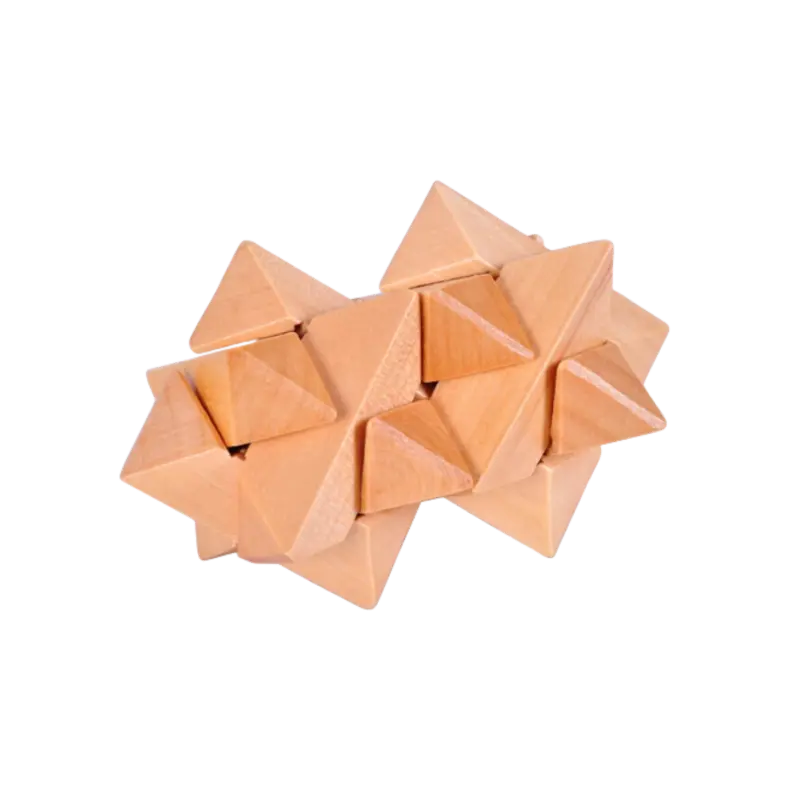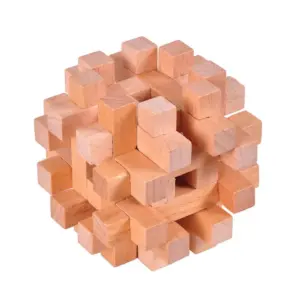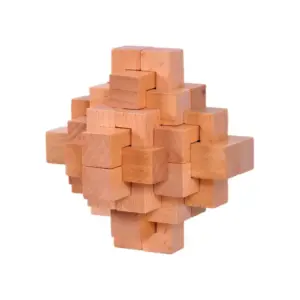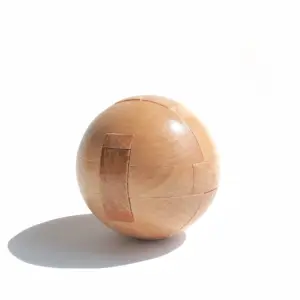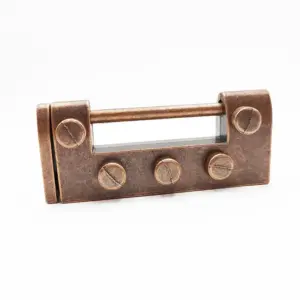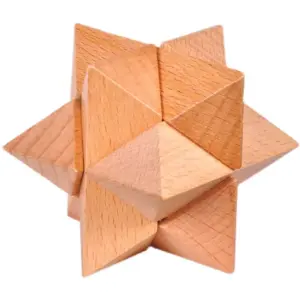What Makes the Twin Star Puzzle So Addictively Challenging?
I’ve been collecting and reviewing wooden puzzles for over fifteen years, and the Twin Star Puzzle still manages to surprise me every time I reassemble it. This isn’t your typical brain teaser that you solve once and forget—it’s a legitimate test of spatial reasoning wrapped in gorgeous woodcraft.
The Twin Star Puzzle belongs to the luban lock family, a category of Chinese interlocking puzzles that date back centuries. What sets this particular design apart is its deceptive simplicity: eleven wooden pieces that look straightforward until you’re staring at them scattered across your table at 2 AM, wondering how they ever fit together in the first place.
The Twin Star Puzzle
- 11-piece precision wooden interlocking puzzle featuring three distinct block types: one elongated core, eight diamond double-pyramids, and two special twisted pieces that challenge spatial reasoning and reward patience
- Embodies timeless craftsmanship philosophy: just as ancient builders created lasting structures through balance rather than force, this luban lock teaches that mastery emerges from understanding inherent order—each piece supports the others, and the complete form exists only through their natural cooperation
- Screen-free brain training that’s satisfyingly difficult to master yet surprisingly addictive—the perfect coffee table centerpiece, gift for puzzle enthusiasts, or personal challenge for anyone seeking tangible problem-solving that improves with practice
Understanding the Three Piece Types
Before you can master the Twin Star Puzzle, you need to understand what you’re working with. The eleven pieces break down into three distinct categories, and recognizing them instantly is half the battle.
The Core Piece (1 piece): This elongated triangular prism is your foundation. It features a V-groove running the entire length, creating that signature channel where other pieces lock in. Think of it as the spine of the entire structure—everything else builds around this single piece.
Standard Double-Pyramid Blocks (8 pieces): These are the workhorses of the puzzle. Each one resembles two pyramids joined at their square bases, creating a diamond-like shape when viewed from the side. The four faces are identical isosceles triangles, which means they can orient in multiple directions. This is where beginners get tripped up—these pieces look interchangeable, but their positioning matters enormously.
Special Twisted Pieces (2 pieces): Here’s where the Twin Star Puzzle earns its difficulty rating. These Z-shaped connectors look like someone took two standard pieces, sliced them at an angle, and reassembled them offset. They’re asymmetrical, twisted, and absolutely critical to the puzzle’s structural integrity. Get these wrong, and nothing else will fit.
Step-by-Step Assembly: The Method That Actually Works
I’ve watched dozens of people attempt the Twin Star Puzzle, and most make the same mistake: they try to force pieces together instead of understanding the sequence. This puzzle rewards patience and precision, not brute force.
Disassembly (The Easy Part)
Taking apart the Twin Star Puzzle requires zero skill. Hold both ends, twist gently in opposite directions, and the structure splits cleanly down its central axis. Continue separating the halves, and all eleven pieces will come loose. Easy enough that a kid could do it—which makes the assembly process all the more humbling.
Sorting Your Pieces
Lay everything out on a flat surface. Identify and separate:
- Your single core piece (the long triangular one)
- Eight standard diamond blocks
- Two special twisted pieces
This organizational step seems obvious, but I’ve seen too many people skip it and waste twenty minutes hunting for specific pieces mid-assembly.
Building the First Half
Here’s where muscle memory starts to develop. Grab your core piece and place it horizontally in front of you.
Step 1: Take one standard block and fit its pyramid tip into the V-groove at one end of the core piece. It should nestle in snugly, with the block oriented perpendicular to the core.
Step 2: On both sides of this first block, place two more standard blocks vertically. These should align with both the core piece and the first block you placed, creating a stable three-piece cluster.
Step 3: Now for the tricky part—slide one of those special twisted pieces into the gap between the two vertical blocks. This requires finesse. You’ll need to angle it just right, and it might take a few attempts to find the sweet spot.
Step 4: The final standard block for this half slides in from above (or below, depending on your orientation). Here’s the key: keep the existing structure slightly loose. If everything’s locked tight, this last piece won’t fit. Give yourself some wiggle room, slide it in, then gently compress everything together.
You’ve now completed half the Twin Star Puzzle. Flip it over while keeping it together in your palm.
Mirror Image: Building the Second Half
This is where the “twin star” name makes sense—you’re essentially creating a mirror image of what you just built.
Repeat the exact same sequence using the remaining pieces:
- One standard block onto the opposite end of the core piece
- Two vertical standard blocks on the sides
- The second special twisted piece between them
- Final standard block sliding in from the opening (again, keep things loose)
The Final Union
When both halves are complete, you’ll have two symmetrical structures connected by that single core piece running through their centers. Align the interfaces where the two halves meet, then gently press them together. They should lock with a satisfying solidity.
If they don’t fit cleanly, don’t force it. Something’s misaligned—usually one of those special twisted pieces is rotated incorrectly. Disassemble the problematic half and try again.
Why the Twin Star Puzzle Still Matters in 2025
In an era where “puzzle” usually means a mobile app you delete after beating level 200, the Twin Star Puzzle offers something increasingly rare: a tactile, mechanical challenge that improves with repetition.
I keep one on my desk specifically for video calls. While clients drone on about quarterly projections, my hands are quietly solving and resolving this eleven-piece brain teaser. It’s meditation disguised as fidgeting, and the smooth wood grain under my fingers beats stress-ball squeezing any day.
What Makes Quality Wooden Puzzles Different
Not all Twin Star Puzzles are created equal. The ones worth buying feature:
- Tight tolerances (pieces should fit snugly without gaps)
- Smooth edges (no splinters or rough spots)
- Consistent wood grain (indicates proper material selection)
- Natural finish (you should smell wood, not chemical varnish)
Cheap versions might look similar in photos, but they fall apart during assembly or have pieces that don’t quite align. The price difference between mediocre and excellent is maybe ten dollars—always worth paying for proper craftsmanship.
Common Mistakes (And How to Avoid Them)
Forcing pieces together: If it doesn’t fit easily, you’re doing something wrong. The Twin Star Puzzle is precision-engineered—force means misalignment.
Ignoring the special pieces: Those twisted Z-shaped blocks aren’t optional decorations. They’re structural linchpins. Get their orientation wrong, and nothing else works.
Skipping the loosening step: When inserting the final piece into each half, you MUST keep the structure slightly loose. Otherwise, physics won’t let that last block slide home.
Rushing the process: This isn’t a speed challenge. The Twin Star Puzzle rewards methodical thinking. Take your time, especially on your first dozen attempts.
Video Tutorial Reference
For visual learners, this YouTube tutorial demonstrates the complete assembly process. Watching the sequence in motion clarifies angles and orientations that are tough to convey in text alone. I recommend attempting it yourself first, then consulting the video if you get stuck.
Who Should Buy the Twin Star Puzzle?
After years of recommending puzzles to friends, family, and random strangers who ask what I do for a living, I’ve identified the ideal Twin Star Puzzle customer:
- Puzzle collectors looking for legitimate challenges beyond standard jigsaws
- Fidgeters who need screen-free hand occupation during meetings or TV
- Gift-givers seeking impressive, non-digital presents for teens and adults
- Educators teaching spatial reasoning, geometry, or problem-solving
- Anyone tired of phone games that waste time without engaging the brain
It’s less ideal for young children (pieces are small and sequence is complex) or people seeking quick, easy entertainment. This is a commitment puzzle that reveals its pleasures gradually.
The Zen of Repetitive Solving
Here’s something nobody tells you about the Twin Star Puzzle: solving it once is an accomplishment. Solving it fifty times is when it gets interesting.
Around attempt twenty, your fingers start moving automatically. The sequence becomes muscle memory. Your brain disengages from conscious problem-solving and enters a flow state. This is when the puzzle transforms from challenge to meditation.
I’ve assembled mine hundreds of times at this point, and I still find it calming. There’s something deeply satisfying about taking chaos (eleven scattered blocks) and creating order (one integrated structure) using only logic and dexterity. No instructions, no apps, no external validation—just you and wood and geometry.
Final Thoughts: Is the Twin Star Puzzle Worth It?
If you’re reading this far, you already know the answer. The Twin Star Puzzle isn’t for everyone, but for the right person, it’s exactly what’s been missing from their desk or coffee table.
It’s challenging without being impossible, beautiful without being fragile, and engaging without requiring a power source. In a world of disposable entertainment, here’s something you’ll still be solving—and enjoying—years from now.
The first assembly might take you two hours. The hundredth will take two minutes. Both experiences are worthwhile.
Frequently Asked Questions
How long does it take to solve the Twin Star Puzzle the first time? Most people need 30 minutes to 2 hours on their first attempt, assuming they’re working systematically. Random trial-and-error can stretch to 5+ hours.
Is the Twin Star Puzzle suitable for beginners? It’s challenging but fair. If you’ve never tried interlocking wooden puzzles before, expect frustration followed by immense satisfaction. Not recommended as someone’s very first puzzle, but perfect as their second or third.
What’s the recommended age for the Twin Star Puzzle? Manufacturers typically suggest 14+, though bright 10-12 year olds with good spatial skills can handle it. The pieces are small enough to be a choking hazard for young children.
Can the Twin Star Puzzle break? High-quality versions are surprisingly durable. The wood can withstand normal use for years. However, dropping it while assembled might crack pieces, and excessive force during assembly can cause damage.
How is the Twin Star Puzzle different from other luban locks? The eleven-piece design and specific use of twisted connector pieces create a unique solving experience. It’s generally considered intermediate difficulty within the luban lock family—harder than six-piece versions, easier than some 20+ piece monsters.

